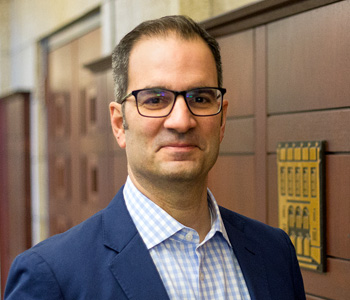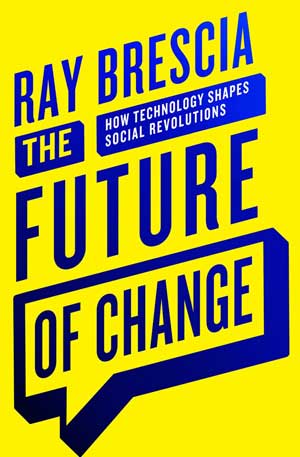
The Future of Change uncovers the relationships between advances in communications technologies and the rise and success of some of the iconic social movements over the course of American history.
Advances in communications technologies and strategies create what I call “social innovation moments.” The printing press was integral to the American Revolution; the steam printing press supercharged the Abolitionist Movement; the telegraph helped spread word about the Seneca Falls Convention, sparking the Women’s Movement of the 19th century; the Civil Rights Movement and the television were inextricably intertwined.
What I argue is that these advances in communications have created these social innovation moments: times when new means of communicating strengthen the ability of social movements to communicate and coordinate action. What often happens in these moments is that activists, who usually face long odds and significant impediments to success, find themselves reaching for the most modern communications tools at their disposal. They then innovate and use these tools in ways that were not necessarily foreseen.
What is more, the movements not only shape these means of communication, but they are also shaped by them. In one contemporary example of this phenomenon, after the shooting in Parkland, FL, the students there, who were sophisticated social media users, showed a deftness with the medium in their efforts to rally supporters and counter the rather feeble social media efforts of their adversaries. By harnessing this new means of communications, these agile activists took their advocacy to new heights, showing how the medium could serve their efforts in powerful ways.
In the end, the book tries to understand this interplay between social movements and innovations in communications over the course of American history so that we can learn from those successes and emulate them now and in the future, because I believe we currently find ourselves in a social innovation moment—one that requires creativity and inspired action to advance meaningful social change.
The book builds on the work of scholars who have noted that social movements changed their shape and focus in the 1970s to become more top-down and professionalized. In the book, I point out that one of the reasons for this shift is that the means of communication changed dramatically.
Grassroots groups used to have to organize into what has been called a “trans-local” structure—local chapters or nodes connected to a larger, national structure. Many groups in the 1970s began to organize in more of a top-down manner and were no longer built into local chapters. I argue in the book that one of the reasons for this was that a new technology came on the scene around this time—the ability to create computerized mailing lists—and this allowed a more centralized, professionalized structure. Groups abandoned the trans-local, grassroots approach that mobilized around face-to-face encounters.
I argue further that, with social media, it is certainly possible to continue this model of organizing but I highlight a number of contemporary case studies where advocates are utilizing social media and other tools to recreate the grassroots, face-to-face organizing of prior eras. They are also rebuilding social capital and trust, two essential ingredients (and by-products) of grassroots, face-to-face organizing that were more common in grassroots movements of prior eras, before the advent of the computerized mailing list.
I hope readers would start with the first few pages of the book. In the introduction, I recount the story of how the American Legion advocated for passage of the GI Bill, which promoted a program of wide-ranging and generous benefits for those who served in the U.S. military during WWII. The campaign included all of the components of what I describe in the book as the social change matrix: a formula for bringing about progressive social change.
Those components include what I call Medium, Network, and Message. The first of these, Medium, involves the use of contemporary communications technologies. The book goes into case after case of successful social movements utilizing the most modern means of communications available to them to advance positive social change. But many successful social movements that I highlight in the book also utilized these other two components of the social change matrix.
The second component, the Network represents the development of the type of trans-local network I have described here. These are groups that have a local base where individual members can meet and confer on a face-to-face basis, but those local nodes are connected to a broader initiative, one that has regional, state, and national reach.
Finally, the last component, Message, reflects the fact that most of these successful social movements have promoted a positive, inclusive message that stresses shared humanity and shared destiny and is often designed to combat inequality in some form, from racial inequality to inequality based on gender or sexual orientation or gender expression. It is here that we see the notion of interest convergence coming into play: groups that embrace a broad, inclusive message are likely to uncover the potential for overlapping interests among different groups.
Even if those interests are not identical, they can converge, and that convergence of interests often invites diverse groups to strive toward a similar goal. And when this occurs, interest convergence can often lead to powerful coalition building. In the story of the passage of the GI Bill, which I return to throughout the work, we can see these different elements of this social change matrix all at play.
My hope is that advocates will learn not just from the examples of successful social change efforts from the past, but also the contemporary case studies I highlight. Advocates can learn how to use the technologies at their disposal today, as well as those that are likely to emerge in the future.
Think of examples like the #MeToo movement or the campaign for Marriage Equality. These efforts have stressed shared humanity and shared destiny. Successful coalitions such as these do not always consist of people or organizations that agree on everything or see the world in completely the same way. Instead, successful coalitions often come together around shared interests, even self-interest: Alexis de Tocqueville, that French observer of American life in the early 19th century, described this as self-interest “well understood”.
When this self-interest is blended across different groups, that is, when a movement experiences what the late Derrick Bell called an “interest convergence,” unlikely alliances can form. Bell argued that the victory in the decision in Brown v. Board of Education came about because the Civil Rights Movement shared the goal of dismantling the Jim Crow system with white elites. Civil rights advocates wanted to attack the system because of its impact on the African-American community. White elites saw that system as harming the American reputation abroad as the U.S. was locked in a cold war with the Soviet Union. This interest convergence ultimately led to the demise of the Jim Crow system.
What I try to do in the book is show other examples of groups forming coalitions in light of the shared interests of sometimes oppositional groups. In one case study, I describe the efforts of a union to raise the minimum wage for hotel workers in Long Beach, CA. The workers attracted allies among the small business community as well as local homeowners. Both of these groups wanted to see local workers earning more so that they would spend more in local shops, improving the quality of life for everyone. The workers and these other groups did not see eye-to-eye on every issue but the coalition they formed was so powerful, and it won a ballot referendum on the issue of hotel workers wages so convincingly, that it had union leaders wondering if they should have asked for an even higher wage than that they were able to secure through the referendum.
What this and other examples in the book show is that coalitions can be created among seemingly unlikely allies if leaders search for areas where interests may overlap, and leverage those overlapping interests to fight for real, lasting, and meaningful change. This book explores how to do that in today’s fast-moving media environment.


Ray Brescia is the Hon. Harold R. Tyler Chair in Law & Technology and a Professor of Law at Albany Law School. He is a former community organizer and lawyer who served communities of color in New York City before joining the faculty at Albany Law in 2007. In addition to authoring The Future of Change: How Technology Shapes Social Revolutions, which is featured in his Rorotoko interview, he is the co-editor, with John Travis Marshall, of How Cities Will Save the World: Urban Innovation in the Face of Population Flows, Climate Change, and Economic Inequality (Routledge, 2016), as well as the co-editor, with Eric K. Stern, of the forthcoming work Crisis Lawyering: Effective Legal Advocacy in Emergency Situations (NYU Press, 2021). Much of his scholarly writing can be found on his SSRN page . He is a graduate of Yale Law School and Fordham University.